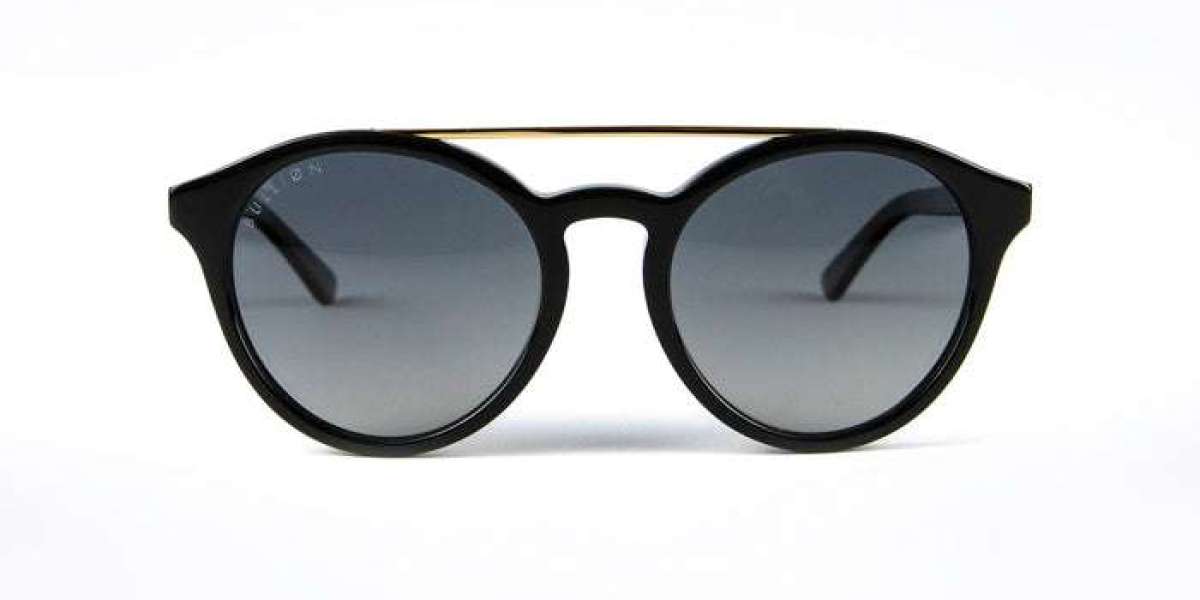Luxury sunglasses are more than a fashion accessory—symbolising status, style, and innovation. Over the years, they have evolved from simple eye protection to iconic fashion and technological advancement statements. This article explores the rich history of luxury sunglasses, tracing their evolution through key icons and innovations that have shaped the industry.
The Origins of Sunglasses: From Utility to Luxury
The history of sunglasses can be traced back to ancient civilisations, where primitive eyewear was used primarily for protection against the sun's glare. In ancient China, for example, judges used flat panes of smoky quartz to protect their eyes during trials. These early versions of sunglasses were purely functional, lacking the style and sophistication of modern luxury sunglasses.
The transformation from utility to luxury began in the early 20th century when sunglasses became more widely available and fashionable. Celebrities and public figures started wearing them for protection and as a style statement. This marked the beginning of sunglasses as a luxury accessory, laying the foundation for developing high-end brands and designer collections.
The Rise of Hollywood Glamour: Sunglasses as a Status Symbol
In the 1920s and 1930s, Hollywood rose as a global entertainment powerhouse, and with it, sunglasses emerged as a symbol of glamour and sophistication. Movie stars like Marlene Dietrich and Greta Garbo popularised sunglasses, wearing them both on and off the screen. Their association with fame and wealth helped cement sunglasses as a luxury item.
Luxury sunglasses became synonymous with Hollywood's allure, and significant fashion houses began recognising their potential. Designers started creating sunglasses that were not just functional but also highly fashionable, incorporating elements of style that appealed to the elite. This era marked the beginning of luxury sunglasses as a must-have accessory for the rich and famous.
Ray-Ban Aviators: The Birth of an Icon
One of the most iconic developments in the history of luxury sunglasses was the creation of Ray-Ban Aviators in 193Originally designed for pilots to protect their eyes from the harsh glare at high altitudes, Aviators quickly became a symbol of coolness and rebellion. Their sleek design and practical features made them famous among aviators and the general public.
Ray-Ban Aviators gained widespread popularity after celebrities like James Dean and Marlon Brando wore them, solidifying their status as cultural icons. The combination of functionality and style made Aviators a staple in luxury sunglasses, influencing countless other designs and becoming a timeless classic.
The Influence of Fashion Designers: Sunglasses as a Fashion Statement
The post-war era saw the influence of significant fashion designers on the world of luxury sunglasses. Designers like Christian Dior, Yves Saint Laurent, and Gucci began incorporating sunglasses into their collections, elevating them to high-fashion status. These designers introduced bold, innovative designs that pushed the boundaries of what sunglasses could be.
Luxury sunglasses became integral to fashion shows and runway collections, with designers experimenting with shapes, colours, and materials. The collaboration between fashion houses and eyewear manufacturers resulted in iconic designs that continue to influence today's industry. Sunglasses were no longer just an accessory but a crucial element of a complete fashion ensemble.
The 1960s and 1970s: The Era of Bold Designs
The 1960s and 1970s were a time of cultural revolution, reflected in luxury sunglasses' bold and unconventional designs. This era saw the introduction of oversized frames, vibrant colours, and avant-garde shapes that challenged traditional notions of style. Designers like Emilio Pucci and Pierre Cardin embraced the spirit of the times, creating sunglasses that were as much a statement piece as they were functional.
Their creativity and innovation characterised luxury sunglasses during this period. The use of new materials like plastic allowed for greater experimentation with shapes and sizes, leading to the development of iconic designs like the oversized "Jackie O" sunglasses popularised by Jacqueline Kennedy Onassis. These designs became emblematic of the era, symbolising freedom, individuality, and a break from convention.
The Influence of Pop Culture: Sunglasses in Music and Film
Pop culture played a significant role in shaping the history of luxury sunglasses. Music icons like Elvis Presley and The Beatles made sunglasses essential to their image, further popularising them. Films like "Breakfast at Tiffany's," where Audrey Hepburn's character donned oversized sunglasses, cemented their place in popular culture.
Luxury sunglasses became closely associated with the rebellious and countercultural movements of the 1960s and 1970s. They were seen as a symbol of coolness and nonconformity, with brands like Ray-Ban and Persol becoming the go-to choices for those looking to emulate their favourite stars. The influence of music and film on sunglasses continues today, with many iconic designs being inspired by or featured in popular media.
The 1980s: The Era of Brand Power
The 1980s marked the rise of brand power in the luxury sunglasses industry. As consumerism grew, so did the importance of brand recognition. Luxury brands like Chanel, Versace, and Dolce & Gabbana began to dominate the market, offering sunglasses that were as much about displaying the brand logo as they were about design and quality.
The prominence of logos and branding on luxury sunglasses became a status symbol. Owning a pair of Chanel or Versace sunglasses was not just about style but about making a statement of wealth and exclusivity. This era also saw the rise of celebrity endorsements, with stars like Madonna and Michael Jackson further boosting the appeal of branded luxury sunglasses.
The Advent of Technological Innovations
The 1990s and 2000s brought significant technological advancements to luxury sunglasses. Brands began incorporating new materials and technologies to enhance the functionality and durability of their products. Polarised lenses, UV protection, and scratch-resistant coatings became standard features in luxury sunglasses, offering superior protection and comfort.
Innovations in manufacturing also allowed for more intricate and precise designs. Titanium frames, gradient lenses, and anti-reflective coatings became popular, providing both aesthetic appeal and practical benefits. These technological advancements improved the quality of luxury sunglasses and allowed brands to differentiate themselves in a competitive market.
The Influence of Luxury Brands: Collaborations and Limited Editions
Collaborations between luxury brands and designers or celebrities have become a significant trend in the luxury sunglasses industry. Limited edition collections, often created in partnership with famous designers or celebrities, have added an element of exclusivity and desirability to luxury sunglasses. These collaborations usually result in unique and innovative designs that attract collectors and fashion enthusiasts alike.
For example, collaborations between brands like Louis Vuitton and artists such as Takashi Murakami have produced iconic and highly sought-after sunglasses. These limited edition pieces are often seen as collector's items, adding a new dimension to the luxury sunglasses market. The exclusivity of these collaborations drives demand and reinforces the idea of luxury sunglasses as a status symbol.
Sustainability in Luxury Sunglasses: A Growing Trend
As the fashion industry faces increasing scrutiny over its environmental impact, sustainability has become a significant focus for luxury sunglasses brands. Many companies now incorporate eco-friendly materials and ethical production practices into their manufacturing processes. Brands like Stella McCartney and Gucci have introduced sustainable eyewear lines, using recycled materials and reducing their carbon footprint.
Sustainable luxury sunglasses appeal to environmentally conscious consumers and align with the broader trend of responsible luxury. These products offer the same level of quality and style as traditional luxury sunglasses but with the added benefit of being environmentally friendly. The growing emphasis on sustainability is likely to shape the future of luxury sunglasses, with more brands adopting eco-friendly practices.
The Digital Age: Online Shopping and Virtual Try-Ons
The rise of e-commerce has revolutionised the way consumers shop for luxury sunglasses. Online platforms offer a vast selection of styles and brands, making it easier than ever for consumers to find the perfect pair. Virtual try-on tools, which use augmented reality (AR) technology, allow customers to see how different sunglasses will look on them before making a purchase.
This digital transformation has made luxury sunglasses more accessible to a global audience. Consumers can now browse and purchase from the comfort of their homes, with the added convenience of virtual try-ons and personalised recommendations. The shift to online shopping has also prompted brands to invest in their digital presence, offering immersive and interactive experiences to engage customers.
The Future of Luxury Sunglasses: Innovation and Customisation
The future of luxury sunglasses is likely to be shaped by continued innovation and a focus on customisation. As technology advances, we can expect more features like intelligent lenses, which can adjust to lighting conditions or even integrate with digital devices. Customisation will also play a significant role, with brands offering personalised designs that cater to individual preferences.
The demand for unique and personalised luxury sunglasses is expected to grow, with consumers seeking products that reflect their style and identity. This trend towards customisation, combined with technological advancements, will likely lead to the creation of stylish, highly functional sunglasses tailored to the wearer's needs.
Conclusion
The history of luxury sunglasses is a rich and fascinating journey that reflects the evolution of fashion, technology, and cultural trends. From their origins as simple eye protection to their status as iconic fashion statements, luxury sunglasses have continuously evolved, driven by innovation and the desire for self-expression. As we look to the future, the blend of style, technology, and sustainability will continue to shape the world of luxury sunglasses, ensuring their place as a timeless and essential accessory.








